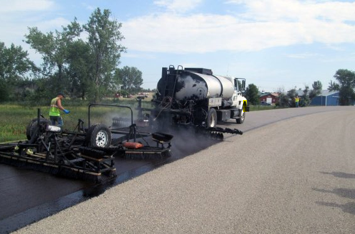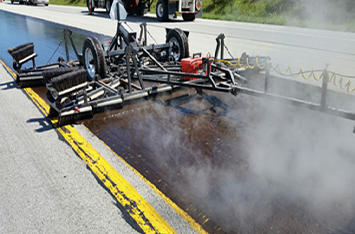Search for articles or browse our knowledge portal by topic.
Scrub Seal


Scrub seals fill and seal low- to moderate-severity cracks and other surface defects, protect asphalt pavements from sunlight and moisture, smooth surface texture, inhibit raveling, and safeguard the underlying pavement structure. Application begins with spraying an asphalt emulsion on the surface. The emulsion may contain polymers, crumb rubber, or rejuvenating oils. The emulsion is then swept or squeegeed mechanically with a drag or broom into small cracks and other surface imperfections. Next, a chip spreader applies a layer of fine aggregate or sand, which is broomed into the surface, followed by another drag broom, which forces the aggregate into emulsion-filled cracks and voids. A pneumatic tire roller then drives over the seal. Typical application rates are 0.15 to 0.40 gal/yd2 of emulsion and 10 to 20 lbs/yd2 of sand or fine aggregate. Excess sand or aggregate is broomed off the roadway a couple of hours after application.
Use scrub seals on structurally sound asphalt pavements with minor- to moderate-severity surface cracking (£ 0.5 inches wide) and other surface problems. They have been used successfully on city streets and major highways.
- Saves money and time by reducing or eliminating the need for sealing cracks prior to applying the asphalt surface treatment.
- With some products, sand or aggregate can be placed up to 30 minutes after applying the emulsion.
- Can use less expensive with up to 6% passing a #200 sieve.
- While sand or fine aggregates may dislodge from the seal, they are normally not heavy enough to damage vehicles.
- Can fill cracks £5 inches wide that normally require crack sealing.
- Not appropriate for rutted, potholed, or rough surfaces.
- Should not be used on unstable pavement structures or pavements with poor drainage.
- Should be applied when the weather will be dry and warm enough to allow thorough curing.
- Emulsion must be tested for its ability to be scrubbed without breaking.
- The necessary equipment and expertise may not be available everywhere.
| Pavement Condition | Scrub Seal Longevity |
|---|---|
| Good | 4 - 6 years |
| Fair | 4 - 6 years |
| Poor | 1 - 4 years |
Pavement Preservation Knowledge Book:
Access the complete Knowledge Book here: Pavement Preservation Knowledge Book
Next Article: 3.4 Chip Seal
Previous Article: 3.2 Rejuvenators

